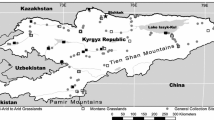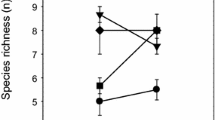Abstract
The Auchenorrhyncha (leafhoppers) show great potential as indicators of grassland habitat quality, which would make them useful as a conservation tool. However, they are known to have labile populations. The relative importance of site identity and the year of sampling in the composition of leafhopper assemblages on chalk grassland are assessed for two sets of sites sampled twice. The study included a total of 95 sites (one set of 54, the other of 41), and demonstrated that for both sets the vegetation community and geographical location had high explanatory value, while the influence of year was small. The conclusion is that, notwithstanding population fluctuations, the leafhopper assemblages are a good indicator of habitat quality, and represent a potentially valuable tool in grassland conservation and restoration.
Similar content being viewed by others
References
InstitutionalAuthorNameADAS (1996) Botanical monitoring of grassland in the South Downs ESA1987–1995. ADAS Report Ministry of AgricultureFisheries and Food London
InstitutionalAuthorNameADAS (1997) Botanical monitoring of grassland in the South Wessex Downs ESA1993–1996. ADAS Report Ministry of AgricultureFisheries and Food London
L. Andrzejewska (1965) ArticleTitleStratification and its dynamics in meadow communities of Auchenorrhyncha (Homoptera) Ekol. Pol. – Seria A XIII 31 687–715
Y. Bishop S.E. Feinberg P.W. Holland (1976) Discrete Multivariate Analysis: Theory and Practice MIT Cambridge, Massachusetts
V.K. Brown C.W.D. Gibson J. Kathirithambi (1992) ArticleTitleCommunity organisation in leafhoppers Oikos 65 97–106
P.D. Carey C. Short C. Morris J. Hunt A. Priscott M. Davis C. Finch N. Curry W. Little M. Winter A. Parkin L.G. Firbank (2003) ArticleTitleThe multi-disciplinary evaluation of a national agri-environment scheme J. Env. Man. 69 71–91 Occurrence Handle10.1016/S0301-4797(03)00120-8
A.J. Cherrill S.P. Rushton (1993) ArticleTitleThe Auchenorrhyncha of an unimproved moorland in northern England Ecol. Entomol. 18 95–103
A. Cherrill S. Rushton R. Sanderson J. Byrne (1997) ArticleTitleComparison of TWINSPAN classifications based on plant bugs, leafhoppers, ground-beetles, spiders and plants Entomologist 116 73–83
E. Duffey M.G. Morris J. Sheail L.K. Ward D.A. Wells T.C.E. Wells (1974) Grassland Ecology and Wildlife Management Chapman Hall London
M.D. Eyre J.C. Woodward M.L. Luff (2001) ArticleTitleThe distribution of grassland Auchenorrhyncha assemblages (Homoptera: Cercopidae, Cicadellidae, Delphacidae) in northern England and Scotland J. Insect Conserv. 5 37–45 Occurrence Handle10.1023/A:1011330624531
J.L. Fleiss (1981) Statistical Methods for Rates and Proportions. Wiley Series in Probability and Mathematical Statistics Wiley New York
J. Ford (1995) ArticleTitleTABLEFIT Comput. Appl. Biosci. 11 575–576
K.G.A. Hamilton (2004) ArticleTitleBugs reveal an extensive long-lost northern tallgrass prairie BioScience 55 49–59
M.O. Hill (1979) TWINSPAN- a FORTRAN Program for Arranging Multivariate Data in an Ordered Two Way Table by Classification of the Individuals and the Attributes Cornell University Ithaca, New York
J.A. Hollier V.K. Brown G. Edwards-Jones (1994) ArticleTitleSuccessional leafhopper assemblages: pattern and process Ecol. Res. 9 185–191
W.E. Holzinger W. Fröhlich H. Günthart P. Lauterer H. Nickel A. Orosz W. Shedl R. Remane (1997) ArticleTitleVorläufiges Verzeichnis der Zikaden Mitteleuropas (Insecta: Auchenorrhyncha) Beiträge zur Zikadenkunde 1 43–62
E. Huusela-Veistola A. Vasarainen (2000) ArticleTitlePlant succession in perennial grass strips and effects on the diversity of leafhoppers (Homoptera, Auchenorrhyncha) Agric. Ecosyst. Environ. 80 101–112 Occurrence Handle10.1016/S0167-8809(00)00143-2
P. Jeanneret B. Schüpbach H. Luka (2003) ArticleTitleQuantifying the impact of landscape and habitat features on biodiversity in cultivated landscapes Agric. Ecosyst. Environ. 98 311–320 Occurrence Handle10.1016/S0167-8809(03)00091-4
R.J. Keymer S.J. Leach (1990) Calcareous grassland – a limited resource in Britain S.H. Hillier D.W.H. Watson D.A. Wells (Eds) Calcareous Grasslands – Ecology and Management Bluntisham Books Huntingdon 11–17
J. Liira K. Zobel R. Magi G. Molenberghs (2002) ArticleTitleVertical structure of herbaceous canopies: the importance of plant growth-form and species-specific traits Plant Ecol. 163 123–134 Occurrence Handle10.1023/A:1020365402855
H. Marchand (1953) ArticleTitleDie Bedeutung der Heuschrecken und Schnabelkerfe als Indikatoren verschiedener Graslandtypen- Ein Beitrag zur Agrarökologie Beitr. Ent. 3 116–162
G.J. Masters V.K. Brown I.P. Clarke J.B. Whittacker J.A. Hollier (1998) ArticleTitleDirect and indirect effects of climate change on insect herbivores: Auchenorrhyncha (Homoptera) Ecol. Entomol. 23 45–52 Occurrence Handle10.1046/j.1365-2311.1998.00109.x
D.I. McCracken E.M. Bignal (1998) ArticleTitleApplying the results of ecological studies to land-use policies and practices J. Appl. Ecol. 35 961–967
M.G. Morris (1971) ArticleTitleDifferences between the invertebrate faunas of grazed and ungrazed chalk grassland. IV Abundance and diversity of Homoptera-Auchenorrhyncha J. Appl. Ecol. 18 37–52
M.G. Morris (1981a) ArticleTitleResponses of grassland invertebrates to management by cutting. IV Positive responses of Auchenorrhyncha J. Appl. Ecol. 18 763–771
M.G. Morris (1981b) ArticleTitleResponses of grassland invertebrates to management by cutting. III Adverse effects on Auchenorrhyncha J. Appl. Ecol. 18 107–123
M.G. Morris K.H. Lakhani (1979) ArticleTitleResponses of grassland invertebrates to management by cutting. I Species diversity of Hemiptera J. Appl. Ecol. 16 77–98
S.R. Mortimer J.A. Hollier V.K. Brown (1998) ArticleTitleInteractions between plant and insect diversity in the restoration of lowland clacareous grasslands in southern Britain Appl. Veg. Sci. 1 101–114
H.J. Müller (1978) ArticleTitleStrukturanalyse der Zikaden fauna (Homoptera Auchenorrhyncha) einer Rasenkatena Thüringens (Leutratal bei Jena) Zool. Jb. Syst. Bd. 105 258–334
H. Nickel (2003) The leafhoppers amd planthoppers of Germany (Hemiptera, Auchenorrhyncha): Patterns and Strategies in a Highly Diverse Group of Phytophagous Insects Pensoft Publishers Moscow-Sofia
H. Nickel J. Hildebrandt (2003) ArticleTitleAuchenorrhyncha communities as indicators of disturbance in grasslands (Insecta, Hemiptera)- a case study from the Elbe flood plains (northern Germany) Agriculture Ecosyst. Environ. 98 183–199 Occurrence Handle10.1016/S0167-8809(03)00080-X
V. Novotný (1991) ArticleTitleResposes of Auchenorrhyncha communities to selected characteristics of littoral and meadow vegetaion Ekologia (CSFR) 10 271–282
G.N. Ovenden A.R.H. Swash D. Smallshire (1998) ArticleTitleAgri-environment schemes and their contribution to the conservation of biodiversity in England J. Appl. Ecol. 35 955–960
R. Remane A. Guglielmino (2002) ArticleTitleFemale ectodermal genitalia of the taxa of the Kelisia guttula group (Homoptera Fulgaromorpha Delphacidae): not only an example for specialized coorganisation with male genitalia without obvious reasons, but also a character set apt for species discrimination in westpalaearctic taxa? Marburger Ent. Publ. 3 21–38
J.S. Rodwell (Eds) (1992) British Plant Communities, Vol. 3, Grasslands and Montane Communities Cambridge University Press Cambridge
Rombach R. 1999. Auswirkungen verschiedener Formen der Bewirtschaftung von Halbtrockenrasen auf die Zikaden (HomopteraAuchenorrhyncha) am Beispiel der Enzian-Schillergras-Rasen (Gentiano-Koelerietum) der Nordeifel (Nordrhein-Westfalen). Dissertation, Universität Bonn.
K.E.J. Stewart N.A.D. Bourn J.A. Thomas (2001) ArticleTitleAn evaluation of three quick methods commonly used to assess sward height in ecology J. Appl. Ecol. 38 1148–1154 Occurrence Handle10.1046/j.1365-2664.2001.00658.x
A.G. Tansley (1939) The British Isles and their Vegetation Cambridge University Press Cambridge
C.J.F. ter Braak P. Smilauer (1998) CANOCO for Windows (version 4) Centre for Biometry Wageningen
UK Biodiversity Group 1998. Tranche 2 Action Plans – Volume II: Terrestrial and freshwater habitats. HMSO.
N. Waloff (1980) ArticleTitleStudies on grassland leafhoppers (AuchenorrhynchaHomoptera) and their natural enemies Adv. Ecol. Res. 11 81–215
N. Waloff (1994) ArticleTitleObservations on Zyginidia scutellaris (Herrich-Schaeffer), Auchenorrhyncha: Typhalocybinae: Cicadellidae Entomologist 113 20–27
N. Waloff M.G. Solomon (1973) ArticleTitleLeafhoppers (Auchenorrhyncha:Homoptera) of acidic grassland J. Appl. Ecol. 10 189–212
N. Waloff P. Thompson (1980) ArticleTitleCensus data of populations of some leafhoppers (AuchenorrhynchaHomoptera) of acidic grassland J. Anim. Ecol. 49 395–416
J.F. Wright D. Moss P.D. Armitage M.T. Furse (1984) ArticleTitleA preliminary classification of running-water sites in Great Britain based on Macroinvertebrate species, and the prediction of community type using environmental data Freshw. Biol. 14 221–256
Author information
Authors and Affiliations
Corresponding author
Rights and permissions
About this article
Cite this article
Hollier, J.A., Maczey, N., Masters, G.J. et al. Grassland Leafhoppers (Hemiptera: Auchenorrhyncha) as Indicators of Habitat Condition – A Comparison of between-site and between-year differences in Assemblage Composition. J Insect Conserv 9, 299–307 (2005). https://doi.org/10.1007/s10841-005-8821-z
Received:
Accepted:
Issue Date:
DOI: https://doi.org/10.1007/s10841-005-8821-z




